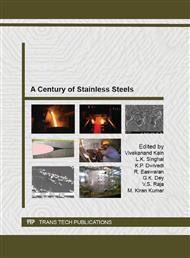p.517
p.530
p.539
p.552
p.564
p.575
p.583
p.592
p.598
Studying the Mechanism behind Stress Corrosion Cracking of Non Sensitized 304L Austenitic Stainless Steel
Abstract:
The susceptibility of non sensitized 304L stainless steel (SS) components towards stress corrosion cracking (SCC) has been studied here in the light of the significant role played by surface working operations. The plant experience shows that the fracture surfaces of non sensitized 304L stainless steel components have no signs of carbide precipitation. However, heavy plastic deformation has been evidenced in the form of high density of slip bands on the surface up to a depth of about 100 μm with high tensile residual stresses near the surface. The present study has established that the primary cause of the increase in SCC susceptibility is the heavy plastic deformation near the surface and high magnitude of tensile residual stresses which is a consequence of the surface finishing operations like machining and grinding. In this study, solution annealed 304L stainless steel has been subjected to a) surface working operations like machining and grinding and b) bulk deformation operations such as 10 % cold rolling operation. The materials in different conditions where then subjected to detailed a) microstructural characterisation, b) electrochemical characterisation and c) tests for determining the stress corrosion cracking susceptibility. The distinct differences in the micro structure as a result of bulk deformation vs. surface deformation of 304L austenitic stainless steel were highlighted and correlated to the susceptibility towards stress corrosion cracking. The effect of surface working on the nature and composition of high temperature (300 °C and 10 MPa) oxide formed on 304L stainless steel has been studied in-situ by contact electric resistance (CER) and electrochemical impedance spectroscopy measurements using controlled distance electrochemistry technique in high purity water (conductivity < 0.1 μScm-1) at 300 °C and 10 MPa in an autoclave connected to a recirculation loop system. The results highlighted the distinct differences in the oxidation behaviour of surface worked material as compared to solution annealed material in terms of specific resistivity and low frequency Warburg impedance.
Info:
Periodical:
Pages:
564-574
Citation:
Online since:
September 2013
Authors:
Price:
Сopyright:
© 2013 Trans Tech Publications Ltd. All Rights Reserved
Share:
Citation:


